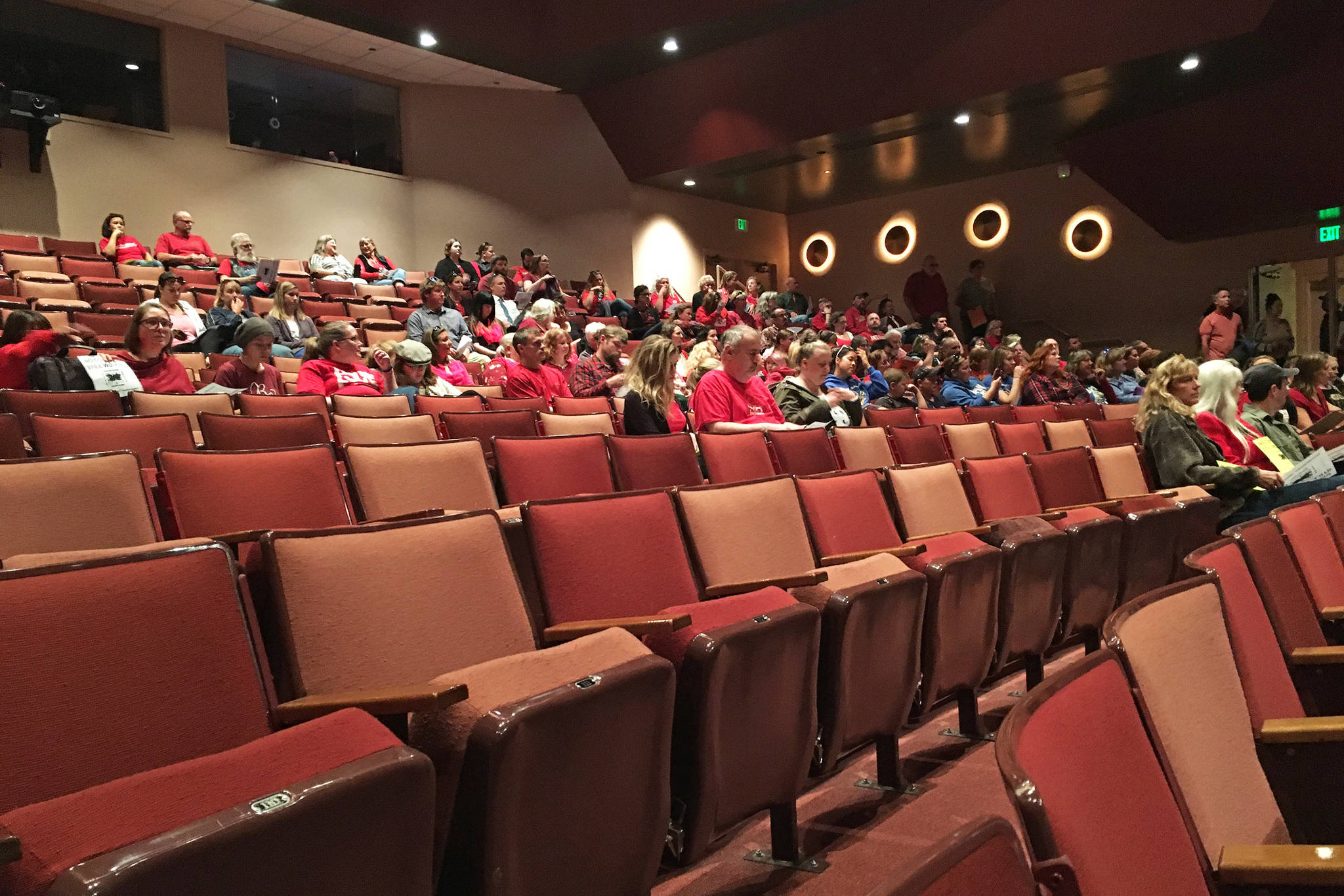Editor’s note: This story has been updated to correct information about how the school district’s health care committee sets rates for health insurance plans. The committee can set whatever rate it chooses.
Homer High School’s colors are blue and gold, but the school’s Mariner Theatre was a sea of red Monday night as teachers and staff protested their 19th day on the job without a contract for the 2018-19 school year.
Teachers, support staff and family members filed into the theater and queued up behind a microphone to submit comments to the Kenai Peninsula Borough School District Board of Education during its annual meeting held in Homer. Most of them dealt with ongoing contract negotiations, and the state of the district’s health insurance plan options. One teacher from Homer Flex School broke down in tears while describing the stress and anxiety high health care costs and financial uncertainty are adding to her life.
Chief among the complaints at Monday’s meeting were complications and frustration with the school district’s health care plans. Heath care was a sticking point in the last round of negotiations, which lasted a year and a half.
Now, the district has two plans for employees — a traditional plan and a high-deductible health plan. Many of the teachers and staff making comments to the board spoke of what they saw as repercussions of that two-plan system. Several teachers said they feel they are essentially being forced to opt for the high-deductible plan. Others said they are worried any raise in pay they are set to receive will be canceled out by the increasingly high health care costs, which board members recognized as a growing problem not only in Alaska but across the country.
Anne McCabe is a member of the district’s health care committee and told the board that insurance works better when a large number of people are all paying into one fund.
“There are a few people who use a lot, and a lot of people who use a little,” she said. “That’s the only way it works.”
McCabe referenced the creation of the district’s high-deductible plan. She said it was good in one regard in that employees needed another option besides the traditional plan.
“But what that did was, it shoved a whole lot of people who don’t use it very much into another plan,” she said. “…It shifted a lot of that over to one side. And now we have a smaller group over here, and the district contributes based on those two plans. So what we did is we created two insurance plans, two separate — not one fund, but now we have a fund for these people and a fund for these people, and I tell you, 100 people can’t be an insurance plan. It’s a problem we need to fix.”
When negotiations started up again earlier this year, the Kenai Peninsula Education Association, which represents teachers, and the Kenai Peninsula Education Support Association, which represents the district’s support staff, both asked for a .5 percent pay increase over one year and a 1 percent increase the following year. This request was in their initial offers. The teachers union asked for a three-year contract.
The district has a Health Care Program Committee, which includes members of the union, an administrator and three other employees. The committee is supposed to determine the final health care rates. The two plans also have to remain separated.
Matt Fischer, a member of that committee, claimed in his public testimony that the committee has asked the school district repeatedly for data he says its members need in order to set those rates. Fischer and other commenters said the district has been slow to respond to requests.
He and others questioned the district’s transparency when it comes to the health care plans and the contract negotiations. Board members at the meeting responded that they are committed to making sure any information being given out is factual. Board member Zen Kelly, a representative from the Southern Kenai Peninsula, said he plans to work to improve district transparency and the accuracy of available information.
“I will commit to that,” he said.
Because a new contract has not been reached by the district, the KPEA, and the KPESA, teachers are currently working within what’s called “dynamic status quo,” which is described on the school district website as working “within the most recent negotiated agreement.”
“Work conditions remain the same as the prior negotiated agreement. All staff eligible for movement on their salary schedule did receive advancement on their respective salary schedules when the new fiscal year 2018-2019 (FY19) began July 1, 2018,” according to the website.
Mediation took place on Aug. 8-9.
The next meeting of the Board of Education is at 6 p.m. on Oct. 15 in the Kenai Peninsula Borough Assembly Chambers in Soldotna.
KPBSD Superintendent Sean Dusek also took time during Monday’s meeting to share an update on district events and where the district currently sits in terms of several statistics. His reports to the board included:Enrollment is down district-wide by about 90 students. “As you know, enrollment drives funding,” he said.
Through its Students in Transition program, the district provides services for homeless students — anything from living in a tent or simply lacking a stable place to stay at night, to staying with extended family members. Dusek said that as of last Friday, the district’s transient student population is hovering at 86. That’s 30 more students than this same time last year, he said.
Dusek will host a “Coffee with the KPBSD Superintendent” meeting at 9 a.m. on Sept. 24 at KBay Caffe & Roasting Co. in Homer.

